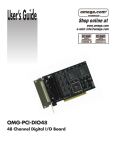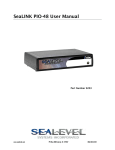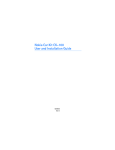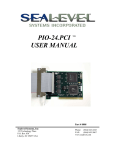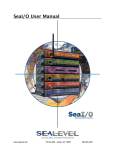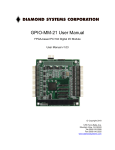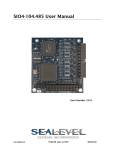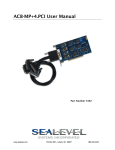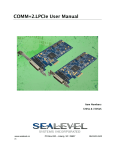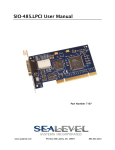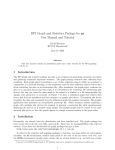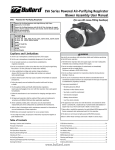Download PIO-48.PC104 User Manual
Transcript
PIO-48.PC104 User Manual Part Number 3701 www.sealevel.com 155 Technology Place Liberty, SC 29657 864.843.4343 Table of Contents TABLE OF CONTENTS ............................................................................................................. 2 INTRODUCTION......................................................................................................................... 4 PIO-48.PC104............................................................................................................................. 4 OTHER SEALEVEL PC104 DIGITAL I/O PRODUCTS ...................................................................... 4 BEFORE YOU GET STARTED................................................................................................. 5 WHAT’S INCLUDED ...................................................................................................................... 5 OPTIONAL ITEMS.......................................................................................................................... 5 CARD SETUP ............................................................................................................................... 7 ADDRESS SELECTION ................................................................................................................... 7 INTERRUPT MODES ...................................................................................................................... 7 IRQ SELECTION ........................................................................................................................... 8 SOFTWARE INSTALLATION .................................................................................................. 9 WINDOWS 98/ME/2000/XP INSTALLATION ................................................................................. 9 LINUX INSTALLATION ................................................................................................................ 10 PHYSICAL INSTALLATION .................................................................................................. 11 3RD PARTY SOFTWARE SUPPORT ................................................................................................ 11 DIGITAL I/O INTERFACE...................................................................................................... 12 50-PIN HEADER CONNECTORS ................................................................................................... 12 PULL UPS ................................................................................................................................... 13 PHYSICAL CONNECTION ............................................................................................................. 14 ELECTRICAL CHARACTERISTICS .................................................................................... 15 SPECIFICATIONS ......................................................................................................................... 15 EXAMPLE CIRCUITS .............................................................................................................. 16 PROGRAMMING THE PIO-48.PC104................................................................................... 17 PROGRAMMING FOR WINDOWS .................................................................................................. 17 PROGRAMMING FOR LINUX ........................................................................................................ 17 DIRECT HARDWARE CONTROL .................................................................................................. 17 READING THE INPUTS................................................................................................................. 17 READING THE OUTPUTS ............................................................................................................. 17 PRESETTING AN OUTPUT PORT .................................................................................................. 18 WRITING THE OUTPUTS ............................................................................................................. 18 PORT C ...................................................................................................................................... 18 REGISTER DESCRIPTION ............................................................................................................. 18 I/O CONTROL WORD .................................................................................................................. 19 INTERRUPT CONTROL................................................................................................................. 20 INTERRUPT MODE SELECT TABLE ............................................................................................... 20 INTERRUPT READ ....................................................................................................................... 20 © Sealevel Systems, Inc. -2- PIO-48.PC104 User Manual APPENDIX A - TROUBLESHOOTING ................................................................................. 21 APPENDIX B - HOW TO GET ASSISTANCE ...................................................................... 22 APPENDIX C – SILK SCREEN – 3701 PCB .......................................................................... 23 APPENDIX D - COMPLIANCE NOTICES............................................................................ 24 FEDERAL COMMUNICATIONS COMMISSION STATEMENT ........................................................... 24 EMC DIRECTIVE STATEMENT .................................................................................................... 24 WARRANTY............................................................................................................................... 25 TRADEMARKS ............................................................................................................................ 25 © Sealevel Systems, Inc. -3- PIO-48.PC104 User Manual Introduction PIO-48.PC104 The PIO-48.PC104 part number 3701 digital I/O interface provides 48 channels of buffered drive digital I/O emulating 8255 mode zero. The PIO-48.PC104 can be utilized for a variety of control and automation applications including control and monitoring of TTL devices (e.g. LEDs, small solenoids, small relays) and interfacing to solid-state relay racks (SSRs) for high-power AC or DC loads. The PIO-48.PC104’s 48 digital I/O channels are accessed via two 50-pin header connectors with industry-standard pin out. Each header provides 24 bits of digital I/O divided into two eight-bit ports and two four bit ports for upper and lower nibble. Each port may be individually configured via software command as input or output to best match your particular application requirements. The PIO-48.PC104 is designed to be used with a variety of Operating Systems including Windows 98/NT/ME/2000/XP, Linux and DOS. The SeaI/O API (Application Programmer Interface) included on CD with the PIO-48.PC104 provides a variety of useful high-level function calls implemented as a Windows dynamic link library (DLL) and as a Linux kernel module and library. In addition to the API, SeaI/O includes sample code and utilities to simplify software development. Other Sealevel PC104 Digital I/O Products DIO-104.REL (P/N 3710) - 16 Reed Relays DIO-104.OPTO (P/N 3720) - 16 Optically Isolated Inputs DIO-32.104 (P/N 3730) - 16 Optically Isolated Inputs/16 Reed Relays © Sealevel Systems, Inc. -4- PIO-48.PC104 User Manual Before You Get Started What’s Included The PIO-48.PC104 is shipped with the following items. If any of these items is missing or damaged please contact Sealevel for replacement. PIO-48.PC104 Adapter Sealevel SeaI/O Software CD Optional Items Depending upon your application, you are likely to find one or more of the following items useful for interfacing the PIO-48.PC104 to real-world signals. All items can be purchased from our website (http:\\www.sealevel.com) or by calling 864-843-4343. For TTL applications: Terminal Block Kit - (Part Number KT107) − Kit includes the TB07 screw terminal block and CA167 ribbon cable for connecting one of the PIO-48.PC104’s 50-pin header connectors to your I/O. 6” Snap track and DIN rail clips are included for DIN rail mounting. IDC 50 to IDC 50 Pin 40" Ribbon Cable (Part Number CA167) − Interfaces each of the PIO-48.PC104’s 50-pin header connectors. Simulation/debug module (Part Number TA01) − Module allows monitoring status of output pins and controlling state of input pins. An LED corresponding to each port bit illuminates to indicate state. Eight position DIP-switches are used to generate input status changes. © Sealevel Systems, Inc. -5- PIO-48.PC104 User Manual For high-current, high-voltage applications: IDC 50 to IDC 50 Pin Ribbon Cable (Part Number CA167) − 40” cable connects the PIO-96.PCI to solid-state relay racks equipped with 50-pin header interface. IDC 50 to IDC 50 Pin Ribbon Cable (Part Number CA135) − 40” cable connects the PIO-96.PCI to solid-state relay racks equipped with 50-pin edge connector. Solid-State Relay Racks: • Quad six position relay rack (Part Number PB24HQ) − Relay rack can accept up to six QSSRs for a total of 24 channels. Features a 50-pin header connector for easy interface via 50conductor ribbon cables. • Quad four position relay rack (Part Number PB16HQ) − Relay rack can accept up to four QSSRs for a total of 16 channels. Features a 50-pin header connector for easy interface via 50conductor ribbon cables. Quad Solid-State Relay Modules: • AC Input (Part Number IA5Q) - Provides 4 channels of discrete I/O interface to monitor AC inputs up to 140V @ 10mA. • DC Input (Part Number IB5Q) - Provides 4 channels of discrete I/O interface to monitor DC inputs from 3.3V to 32V. • AC Output (Part Number OA5Q) - Provides 4 channels of discrete I/O interface to control AC outputs up to 140V @ 3A. • DC Output (Part Number OB5Q) - Provides 4 channels of discrete I/O interface to control DC outputs up to 60V @ 3A. Simulation/debug module (Part Number TA01) − Module simulates the operation and load characteristics of a standard 24-channel relay rack. An LED corresponding to each port bit illuminates to indicate state. Eight position DIP-switches are used to generate input status changes. © Sealevel Systems, Inc. -6- PIO-48.PC104 User Manual Card Setup Address Selection The PIO-48.PC104 occupies 8 consecutive I/O locations. The DIP-switch (S1) is used to set the base address for these locations and the IRQ mode options. Be careful when selecting the base address as some selections conflict with existing PC ports. The following table shows several examples that usually do not cause a conflict. Hex Address 100-107 180-187 200-207 280-287 300-307 380-387 3A0-3A7 Binary 01 0000 xxxx 01 1000 xxxx 10 0000 xxxx 10 1000 xxxx 11 0000 xxxx 11 1000 xxxx 11 1010 xxxx A9 1 On On Off Off Off Off Off A8 2 Off Off On On Off Off Off A7 3 On Off On Off On Off Off A6 4 On On On On On On On A5 5 On On On On On On Off A4 6 On On On On On On On ON 1 2 3 4 5 6 7 8 9 8 7 6 5 4 S M Interrupt Modes DIP-Switch positions ‘S’ and ‘M’ on switch S1 selects the interrupt mode for each adapter. With the ‘S’ selected, the adapter is in a (S)hared interrupt mode, which allows more than one adapter to access a single IRQ. ‘M’ indicates the inclusion of a 1K-ohm pull-down resistor required on one adapter when sharing interrupts. Set the switch to ‘S’ for shared interrupt mode on all adapters sharing an IRQ. On one of the adapters sharing an interrupt set the switches for both ‘S’ and for ‘M’. This provides the pull-down resistor circuit that makes sharing IRQs possible. If you are using more than one compatible adapter in a bus you should only have one adapter set to ‘M’. © Sealevel Systems, Inc. -7- PIO-48.PC104 User Manual IRQ Selection IRQ3 IRQ15 IRQ12 IRQ11 IRQ10 IRQ9 IRQ7 IRQ5 IRQ4 The PIO-48.PC104 has an interrupt selection jumper, which should be set prior to use, if an interrupt is required by your application software. Consult the user manual for the application software being used to determine the proper setting. Note: The supplied driver for both Windows and Linux does not require, nor does it support interrupts. It is recommended that this jumper be removed to prevent any resource conflicts. © Sealevel Systems, Inc. -8- PIO-48.PC104 User Manual Software Installation Windows 98/ME/2000/XP Installation 1. Start Windows. 2. Insert the Sealevel Systems CD in to your CD drive. 3. If ‘Auto-Start’ is enabled for this drive the software will automatically launch. Otherwise, point your browser to the ‘Index.htm’ on the root directory of the CD 4. Select ‘Install Software’. 5. Select the Part Number for your adapter from the listing. 6. Select ‘Windows 98/NT/ME/2000/XP’. The setup file will automatically detect the operating environment and install the proper components. Next (depending on your browser) select the ‘Run this program from its current location’ or ‘Open’ option. Follow the information presented on the screens that follow. During setup the user may specify installation directories and other preferred configurations. This program also adds entries to the system registry that are necessary for specifying the operating parameters for each driver. An uninstall option is also available to remove SeaIO files and registry/INI file entries from the system. 7. If installing in NT, skip to ‘Windows NT Card Installation’ step 16. 8. Go to the “Add New Hardware Wizard” in the Control Panel. 9. When the Wizard asks if you want Windows to search for the new hardware, choose “No, I want to select the hardware from a list.” 10. Scroll through the list of categorized hardware and select ‘SeaIO Devices’. If this is the first SeaIO device you may need to select ‘Other Devices’ and ‘Sealevel Systems, Inc.’ instead of ‘SeaIO Devices’. 11. Click “Next”. 12. Select the card model and press “Next”. 13. The Wizard will guide you through a few more informational prompts; continue to click “Next” until it is completed. 14. Your card’s resource assignments may be adjusted through the Device Manager (if, for instance, you need to change the I/O port address Windows assigned when you installed the card). 15. Windows software installation is complete 16. Windows NT Card Installation: After accomplishing steps 1 – 6, bring up the Control Panel and double-click on the SeaIO Devices icon. To install a new card, click “Add Port”. Repeat this procedure for as many SeaIO cards as you wish to install. © Sealevel Systems, Inc. -9- PIO-48.PC104 User Manual Linux Installation Note: You MUST have "root" privileges to install the software and drivers. 1. Login as "root". 2. Mount the CDROM by typing: mount -t iso9660 /dev/hdc /cdrom Note: Your cdrom may not be /dev/hdc it could be /dev/hda, /dev/hdb, /dev/hdd, or if you have a SCSI drive /dev/sda, /dev/sdb, /dev/sdc, etc. You may mount the CDROM to any location, the /cdrom is just a common example. 3. Next change to the directory where you mounted the CDROM: Ex. cd /cdrom/software/SeaIO/Other/linux Note: The syntax is case sensitive. 4. Copy seaio .tar.gz to your home directory by typing: cp seaio .tar.gz ~ 5. Change to your home directory by typing: cd 6. Unmount the drive and then Unzip and Untar the drivers and software by typing: umount /cdrom tar -xvzf seaio .tar.gz 7. Change to the SeaIO directory by typing: cd SeaIO 8. Now compile and prepare the drivers for use: make install 9. Using your favorite text editor, edit the /etc/seaio.conf 10. Within the quote marks, insert cardtype=0xYourSeaIOcardType io=0xCardBaseAddress Note: YourSeaIOcardType = Model Number of your SeaIO Card. CardBaseAddress = What base address you have your SeaIO card addressed at. 11. Save the file and exit your editor. 12. Load the driver by typing: SeaIO -load The driver has enabled the card and is ready to use, and you now have the option to run a test utility on it. Skip to section "Using the test software" if you wish to do so at this time. To set up Linux to automatically load the driver; refer to a Linux manual concerning your specific distribution for help. © Sealevel Systems, Inc. - 10 - PIO-48.PC104 User Manual Physical Installation Extreme care should be taken when installing the PIO-48.PC104 to avoid causing damage to the connectors. After the adapter is installed, connect your I/O cables to P2 and P5. Please note these headers are keyed so that pin 1 of the cable matches pin 1 of the connector. Refer to Card Setup for information on setting the address and jumper options before inserting the PIO-48.PC104 onto the stack. Do not install the Adapter in the machine until the software has been fully installed. 1. Turn off power. Disconnect the power cord. 2. Gently insert the PIO-48.PC104 connector noting proper key orientation of the expansion connector on a PC/104 compatible card. The PIO-48.PC104 adapter is keyed per the current PC/104 Specification. This will aid in preventing the adapter from being inserted incorrectly. 3. Mounting hardware (nylon stand-offs and screws) is provided to ensure a good mechanical connection. Retain any mounting hardware not used to allow for future expansion. 4. The cables provided are keyed and can be installed before or after the adapter is inserted in the stack. 5. Connect the power cord and power up the machine. The PIO-48.PC104 is now ready for use. 3rd Party Software Support Third party software support for many HMI/MMI and other process control software is included on the product installation CD. For the most up to date information on third party software support, please visit: http://www.sealevel.com/thirdpartysoftware.asp © Sealevel Systems, Inc. - 11 - PIO-48.PC104 User Manual Digital I/O Interface The PIO-48.PC104’s 48 digital I/O channels are accessed via four industry-standard 50-pin header connectors. Each header provides 24 bits of digital I/O divided into two eight-bit ports and two four bit ports for upper and lower nibble. Each port may be individually configured via software command as input or output. 50-pin Header Connectors You will need to install the cables to the PIO-48.PC104 prior to installing it in the PC. Each of the 50-pin connectors has the following pin out which is compatible with a wide variety of solid state relay racks: © Sealevel Systems, Inc. - 12 - PIO-48.PC104 User Manual Pull Ups Eight resistors are installed to provide pull-ups to the input ports. These are installed on all ports. The pull-up resistors are rated at 10K ohms. Figure 4 below provides the resistors and corresponding port. The resistors ensure that no line is floating which is not connected. This provides consistent biasing on all un-terminated lines. © Sealevel Systems, Inc. Resistor Corresponding Port R34-R41 Port A1 R42-R49 Port B1 R50-R53 Port C1L R54-R57 Port C1U R1-R8 Port A2 R9-R16 Port B2 R17-R20 Port C2L R21-R24 Port C2U - 13 - PIO-48.PC104 User Manual Physical Connection The port signals for the PIO-48.PC104 are physically connected via two 50-pin box headers. P5 provides the connections for ports A1-C1 and P2 provide the connections for A2-C2. These headers are compatible with the industry standard 50pin ribbon/IDC type cabling. This allows for a direct cabling connection between the PIO-48.PC104 and a Solid State Relay Rack (i.e. PB-8. PB-16, PB-24 etc.) The following table shows the correlation between the port addresses and the 50-pin connections. Description Pin # Port A A0 47 A1 45 A2 43 A3 41 A4 39 A5 37 A6 35 A7 33 Port B B0 31 B1 29 B2 27 B3 25 B4 23 B5 21 B6 19 B7 17 Port C C0L 15 C1L 13 C2L 11 C3L 9 C4U 7 C5U 5 C6U 3 C7U 1 GND +5V © Sealevel Systems, Inc. All Even pins 49 - 14 - PIO-48.PC104 User Manual Electrical Characteristics The PIO-48.PC104 uses 74LS245 octal bi-directional transceivers to provide TTL input/output capabilities. Each bit is pulled to +5V through a 10K ohm pull-up resistor to insure each bit is at a known state when not driven. Specifications Inputs Logic High: Logic Low: Min 2VDC Max 0.8VDC Outputs Logic High: Logic Low: Min 2VDC @ 15 mA Max 0.55VDC @ 24 mA Recommended Operating Conditions Inputs: Inputs: Source: Sink: Min 0V Max 5.25V 15mA 24mA Temperature Range Operating: Storage: 0°C – 70°C -50°C – 105°C Power Requirements +5VDC @ 794mA Physical Dimensions Length: Height: © Sealevel Systems, Inc. 3.550 inches (9.017cm) 3.775 inches (9.589cm) - 15 - PIO-48.PC104 User Manual Example Circuits © Sealevel Systems, Inc. - 16 - PIO-48.PC104 User Manual Programming the PIO-48.PC104 Sealevel’s SeaI/O software is provided to assist in the development of reliable applications for the Sealevel Systems family of digital I/O adapters. Included on the SeaI/O CD are driver functions for use in accessing the I/O as well as helpful samples and utilities. Programming for Windows The SeaI/O API (Application Programmer Interface) provides a variety of useful high-level function calls implemented in a Windows dynamic link library (DLL). The API is defined in the help file (Start/Programs/SeaIO/SeaIO Help) under “Application Programmers Interface”. This help file also includes detailed information dealing with installation / removal of the software and information about latency, logic states, and device configuration. For C language programmers we recommend using the API to access the PIO-48.PC104. If you are programming in Visual Basic, using the ActiveX control included with SeaI/O is advised. Samples and Utilities A variety of sample programs and utilities (both executable and source code) are included with SeaI/O. Further documentation on these samples can be found by selecting “Start/Programs/SeaIO/Sample Application Description”. Information about where the files are physically stored on your disk is also included in this same file. Programming for Linux SeaI/O for Linux consists of two major parts: a kernel module and a library. The kernel module is a simple IO pass-through device, allowing the library to handle the more sophisticated functions provided to SeaI/O users. It is provided in a ‘tarball’ format and can easily be compiled and included in the kernel build. Direct Hardware Control In systems where the users program has direct access to the hardware (DOS) the tables that follow give the mapping and functions that the PIO-48.PC104 provides. Reading the Inputs The inputs are active high. If an input is driven high (2V to 5.25 V) it will read as a logical one, if driven low (0V to 0.8V) it will read as a logical zero. If an input is not driven it will read as a one due to the 10K ohm pull up resistors on each port. Reading the Outputs The value that is currently being used to drive the outputs will be returned. © Sealevel Systems, Inc. - 17 - PIO-48.PC104 User Manual Presetting an Output Port Each port has an output register associated with it. This register may be written and retains its value whether the port is configured as an input or an output. To preset the value of an output port the program should write to the port when it is configured as an input then configure it as an output. Writing the Outputs The outputs are active high. Writing a one (1) corresponds to 5V while writing a zero (0) corresponds to 0V, at the output. Port C Port C is written and read to as two four bit ports. If both lower and upper nibbles are configure the same then no special considerations need to be made. But if they are configured differently, one nibble as input, and one as output then the user will have to keep this in mind. When reading, the input will be returned on the corresponding upper or lower nibble while the current outputs will be returned on their corresponding upper or lower nibble. When writing, the corresponding nibble will be written to the output nibble, while the input nibble will have its output register written to. The output register can be written to without affecting the inputs. Register Description Address Base+0 Base+1 Base+2 Base+3 Base+4 Base+5 Base+8 Base+9 Base+A (10) Base+B (11) Base+C (12) Port A1 Port B1 Port C1 Control Word Port 1 Interrupt config Port 1 Interrupt status Port 1 and 2 Port A2 Port B2 Port C2 Control Word Port 2 Interrupt config Port 2 © Sealevel Systems, Inc. Mode D7 D6 RD/WR RD/WR RD/WR WR RD/WR RD RD/WR RD/WR RD/WR WR RD/WR PA1D7 PB1D7 PC1D7 0 0 0 PA2D7 PB2D7 PC2D7 0 0 PA1D6 PB1D6 PC1D6 0 0 0 PA2D6 PB2D6 PC2D6 0 0 - 18 - D5 D4 D3 D2 PA1D5 PA1D4 PA1D3 PA1D2 PB1D5 PB1D4 PB1D3 PB1D2 PC1D5 PC1D4 PC1D3 PC1D2 0 CW1D4 CW1D3 0 0 0 0 IRQEN1 0 IRQST2 0 0 PA2D5 PA2D4 PA2D3 PA2D2 PB2D5 PB2D4 PB2D3 PB2D2 PC2D5 PC2D4 PC2D3 PC2D2 0 CW2D4 CW2D3 0 0 0 0 IRQEN2 D1 D0 PA1D1 PB1D1 PC1D1 CW1D1 IRQC11 0 PA2D1 PB2D1 PC2D1 CW2D1 IRQC21 PA1D0 PB1D0 PC1D0 CW1D0 IRQC10 IRQST1 PA2D0 PB2D0 PC2D0 CW2D0 IRQC20 PIO-48.PC104 User Manual I/O Control Word Each port may be configured as either Input or Output. This is accomplished by writing the correct Control Word (CW) to the proper register. CWnD0 CWnD1 CWnD2 CWnD3 CWnD4 CWnD5 CWnD6 CWnD7 Port C1 lower nibble (bits 0-3) Port B1 6 X X X X X X X X X X X X X X X X 0 = output 0 = output 1 on power up 1 on power up 0 = output 0 = output 1 on power up 1 on power up 0 or 1 (no effect) Port C1 upper nibble (bits 4-7) Port A1 1 = input 1 = input 0 or 1 (no effect) 0 or 1 (no effect) 0 or 1 (no effect) Control Word (X = 0) 7 X X X X X X X X X X X X X X X X 1 = input 1 = input 5 X X X X X X X X X X X X X X X X 4 0 0 0 0 0 0 0 0 1 1 1 1 1 1 1 1 3 0 0 0 0 1 1 1 1 0 0 0 0 1 1 1 1 © Sealevel Systems, Inc. 2 X X X X X X X X X X X X X X X X Hex Value 1 0 0 1 1 0 0 1 1 0 0 1 1 0 0 1 1 0 0 1 0 1 0 1 0 1 0 1 0 1 0 1 0 1 80 81 82 83 88 89 8A 8B 90 91 92 93 98 99 9A 9B - 19 - Port Setup A Out Out Out Out Out Out Out Out In In In In In In In In B Out Out In In Out Out In In Out Out In In Out Out In In C Upper Out Out Out Out In In In In Out Out Out Out In In In In C Lower Out In Out In Out In Out In Out In Out In Out In Out In PIO-48.PC104 User Manual Interrupt Control When enabled interrupts are generated on port bit A0 of each port (pin 47 on each 50 pin header), the port A0 must be set as an input. X = port number IRQENX IRQCX0 IRQCX1 interrupt enable 1 = enabled 0 = disabled ( 0 on power up ) Interrupt mode select see table Interrupt mode select see table Interrupt mode select table IRQCn1 IRQCn0 0 0 0 1 1 0 1 1 Interrupt Read INT Type Low level High level Falling edge Rising edge Reading the INTSTAT port (Base+5) clears any interrupt pending. IRQST1 IRQST2 (D0) Interrupt status (D4) Interrupt status © Sealevel Systems, Inc. 1 = interrupt pending, 0 = none 1 = interrupt pending, 0 = none - 20 - PIO-48.PC104 User Manual Appendix A - Troubleshooting Following these simple steps can eliminate most common problems. Install software first. After installing the software then proceed to adding the hardware. This places the required installation files in the correct locations. Read this manual thoroughly before attempting to install the adapter in your system. Use Device Manager under Windows to verify proper installation. Use the SeaIO Control Panel applet or the Device Manager’s property page for card identification and configuration. If these steps do not solve your problem, please call Sealevel Systems’ Technical Support, (864) 843-4343. Our technical support is free and available from 8:00AM5PM Eastern Time Monday through Friday. For email support contact mailto:[email protected]. © Sealevel Systems, Inc. - 21 - PIO-48.PC104 User Manual Appendix B - How To Get Assistance Begin by reading through the Trouble Shooting Guide in Appendix A. If assistance is still needed please see below. When calling for technical assistance, please have your user manual and current adapter settings. If possible, please have the adapter installed in a computer ready to run diagnostics. Sealevel Systems provides an FAQ section on its web site. Please refer to this to answer many common questions. This section can be found at http://www.sealevel.com/faq.asp Sealevel Systems maintains a Home page on the Internet. Our home page address is http://www.sealevel.com. The latest software updates, and newest manuals are available via our FTP site that can be accessed from our home page. Technical support is available Monday to Friday from 8:00 a.m. to 5:00 p.m. eastern time. Technical support can be reached at (864) 843-4343. RETURN AUTHORIZATION MUST BE OBTAINED FROM SEALEVEL SYSTEMS BEFORE RETURNED MERCHANDISE WILL BE ACCEPTED. AUTHORIZATION CAN BE OBTAINED BY CALLING SEALEVEL SYSTEMS AND REQUESTING A RETURN MERCHANDISE AUTHORIZATION (RMA) NUMBER. © Sealevel Systems, Inc. - 22 - PIO-48.PC104 User Manual Appendix C – Silk Screen – 3701 PCB © Sealevel Systems, Inc. - 23 - PIO-48.PC104 User Manual Appendix D - Compliance Notices Federal Communications Commission Statement FCC - This equipment has been tested and found to comply with the limits for Class A digital device, pursuant to Part 15 of the FCC Rules. These limits are designed to provide reasonable protection against harmful interference when the equipment is operated in a commercial environment. This equipment generates, uses, and can radiate radio frequency energy and, if not installed and used in accordance with the instruction manual, may cause harmful interference to radio communications. Operation of this equipment in a residential area is likely to cause harmful interference in such case the user will be required to correct the interference at the users expense. EMC Directive Statement Products bearing the CE Label fulfill the requirements of the EMC directive (89/336/EEC) and of the low-voltage directive (73/23/EEC) issued by the European Commission. To obey these directives, the following European standards must be met: EN55022 Class A - “Limits and methods of measurement of radio interference characteristics of information technology equipment” EN55024 – “Information technology equipment Immunity characteristics Limits and methods of measurement”. EN60950 (IEC950) - “Safety of information technology equipment, including electrical business equipment” Warning This is a Class A Product. In a domestic environment, this product may cause radio interference in which case the user may be required to take adequate measures to prevent or correct the interference. Always use cabling provided with this product if possible. If no cable is provided or if an alternate cable is required, use high quality shielded cabling to maintain compliance with FCC/EMC directives. © Sealevel Systems, Inc. - 24 - PIO-48.PC104 User Manual Warranty Sealevel's commitment to providing the best I/O solutions is reflected in the Lifetime Warranty that is standard on all Sealevel manufactured products. We are able to offer this warranty due to our control of manufacturing quality and the historically high reliability of our products in the field. Sealevel products are designed and manufactured at its Liberty, South Carolina facility, allowing direct control over product development, production, burn-in and testing. Sealevel Systems, Inc. (hereafter "Sealevel") warrants that the Product shall conform to and perform in accordance with published technical specifications and shall be free of defects in materials and workmanship for life. In the event of failure, Sealevel will repair or replace the product at Sealevel's sole discretion. Failures resulting from misapplication or misuse of the Product, failure to adhere to any specifications or instructions, or failure resulting from neglect or abuse are not covered under this warranty. Warranty service is obtained by delivering the Product to Sealevel and providing proof of purchase. Return authorization must be obtained from Sealevel Systems before returned merchandise will be accepted. Authorization is obtained by calling Sealevel Systems and requesting a Return Merchandise Authorization (RMA) number. The Customer agrees to insure the Product or assume the risk of loss or damage in transit, to prepay shipping charges to Sealevel, and to use the original shipping container or equivalent. Warranty is valid only for original purchaser and is not transferable. Sealevel Systems assumes no liability for any damages, lost profits, lost savings or any other incidental or consequential damage resulting from the use, misuse of, or inability to use this product. Sealevel Systems will not be liable for any claim made by any other related party. This warranty applies to Sealevel manufactured Product. Product purchased through Sealevel but manufactured by a third party will retain the original manufacturer's warranty. Sealevel Systems, Incorporated 155 Technology Place P.O. Box 830 Liberty, SC 29657 USA (864) 843-4343 FAX: (864) 843-3067 www.sealevel.com email: [email protected] Technical Support is available Monday - Friday from 8 a.m. to 5 p.m. Eastern time Trademarks Sealevel Systems, Incorporated acknowledges that all trademarks referenced in this manual are the service mark, trademark, or registered trademark of the respective company. © Sealevel Systems, Inc. - 25 - PIO-48.PC104 User Manual

























